
Note: For the fullest experience, I recommend listening to the podcast, as the audio version always contains additional comments and tangents not found in the blog post version.
 I was at a friend’s son’s bar mitzvah on Saturday, and at the luncheon after the service I sat across from another friend I hadn’t seen in ages. She wanted to know what I’ve been up to since we last spoke, so I explained that I started a consultancy that helps teams and organizations cultivate cultures of creativity, so they can become hotbeds of innovation.
I was at a friend’s son’s bar mitzvah on Saturday, and at the luncheon after the service I sat across from another friend I hadn’t seen in ages. She wanted to know what I’ve been up to since we last spoke, so I explained that I started a consultancy that helps teams and organizations cultivate cultures of creativity, so they can become hotbeds of innovation.
She was surprised that such a niche existed. “Don’t companies just hire innovative people?” she asked. “Why would they need to cultivate a culture of creativity?”
It sounds like a reasonable enough question, but if we take a moment to unpack it, it’s based on flawed logic. But not uncommon logic.
Embedded in this question is one of the biggest challenges I face as a creativity instigator: the belief that creativity is an inborn talent that one either has or doesn’t have.
“Don’t companies just hire innovative people?” implies that creativity is a characteristic like brown eyes, or size 9 feet, or naturally curly hair. You’re either “innovative” and “creative” or you’re not.
The reality, of course, is that humans are an inherently creative species, but our innate creativity can either be stifled or helped to flourish by the culture we operate in.
Although conventional wisdom would have us believe that creativity is the gift of the lone artist or inventor, toiling away in his (and yes, typically it’s a he) isolated garrett studio or laboratory, several books have come out recently disproving this notion. (See, for example, Powers of Two: How Relationships Drive Creativity, by Joshua Wolf Shenk, and Group Genius: The Creative Power of Collaboration, by Keith Sawyer.) In fact, the most powerful creative work typically comes out of collaborations and partnerships, which allow for creative abrasion, and ideas bouncing around and expanding off each other.
Not all groups are beneficial, however. The dynamics of the group make all the difference. Those dynamics — the stories the group tells, how the people in the group communicate with each other, the values and behaviors — all of these make up the culture.
Basically, anything that you can boil down into the statement “People like us do things like this,” is culture. And culture can either help creativity and innovation flourish, or it can completely shut it down.
Let’s look at some examples.
Schools have cultures.
At my elementary school I learned to tie my shoes, color inside the lines, and that the sky always needs to be blue and the grass always needs to be green. I learned that the way to succeed is to please a single authority figure (also known as the teacher). I became the quintessential straight-A student, but I did not learn to think creatively.
I would call this a culture of perfectionism, not a culture of creativity.
Classrooms have cultures.
When my 4th grade teacher tore my friend Laura’s drawing of a mission up because “missions aren’t orange,” I learned that there were “right” ways of drawing, and dire consequences if you did it “wrong.” You would be shamed in front of the entire class.
I became very attuned to this teacher’s moods, but I did not learn to think creatively.
I would call this a culture of fear, not a culture of creativity.
Families have cultures.
We had crayons and markers and tons of computer paper for us to draw on in my household growing up. When I was in 2nd grade, my parents thought I would grow up to be an artist, and that was fine with them. We played board games and word games, and my brother and I had lots of free time to play make-believe with our friends.
There was a piano in the living room that my mom played and that I was encouraged to play whenever I wanted. We listened to music, and we had music lessons and art classes, and my parents played guitar for awhile, before taking up new instruments in their 50s. My dad always sang and whistled around the house, and together we would make up little operettas about my cat.
I still had creativity scars from school, but from my family I learned that art and music were normal, fun parts of life.
Contrast this with a client I worked with, whose mother literally forbade her from doing creative activities, out of a twisted sense of trying to protect her from becoming a “starving artists” as an adult.
She is still trying to reclaim her creative self.
Can you see how my family culture was much more of a culture of creativity than my client’s family culture?
Cultivating a Culture of Creativity
Guess what? Not much changes when we become adults. Human dynamics are human dynamics, and culture is culture.
Companies have cultures, and each team or group inside a company or organization has its own culture, too.
So how do we create a culture of creativity and innovation? Well, Mike Ganino, author of Company Culture for Dummies, said in a recent interview on the podcast, “[culture] all comes down to relationships and communication.” Starting with your relationship with yourself.
“Even a relationship and the way we communicate with ourselves impacts culture,” says Mike.
Which is why it is essential to start at the smallest building block of any team or organization: the individual.
Not to make them “more creative” or “more innovative” — we’ve already established that humans are inherently creative and innovative. The real problem is that, because of the stifling cultures many of us grew up in, many of us have acquired a sense of learned helplessness around our creativity that needs to be peeled away:
- creativity scars
- false beliefs and self-doubts
- imposter complex
The gremlin voices in our heads say things like, “I’m not creative,” “I’m not an artist,” “I’m too old/too young,” “Nobody’s interested in what I have to say,” “I can’t draw/sing/write/act…” and we believe them.
For some, the fear and anxiety around activities even remotely smacking of “artistic” or “creative” is extreme.
First Building Block: The Individual
The intervention here is to start to introduce Creative Sandbox Way™ concepts, gently shifting their individual mindset so they can start to acknowledge and claim their innate creativity, and give themselves permission to use that creativity more freely.
The goal here is not necessarily to get people playing with art supplies (though they are certainly welcome to if they want to, and my book, The Creative Sandbox Way, invites readers to write and doodle in its pages, along with trying a variety of other creative activities). At this point we are simply looking to start a mindset shift. For best results, we’re also looking to invite people to try some kind of simple creative practice that they can engage in regularly, consistent with Guidepost #4, Think tiny and daily.
Doodling for ten minutes a day, for example.
Or freewriting for fifteen minutes a day.
Or taking photos with their smartphone for ten minutes a day.
Or improvising new tunes on their guitar for ten minutes a day.
The essential ingredients for this “Tiny and daily” practice are that it:
- Be ridiculously achievable (i.e., a time commitment of no more than ten or fifteen minutes; even less if that feels too onerous!)
- Require only tools/materials that are easy to have on hand (tip: set those tools/materials out where they are readily available, at your workspace, so you don’t have to spend any time finding them, setting them up, or taking them out of a case!)
- Feel like play (consistent with Guidepost #2: Think process, not product)
Why is this individual tiny and daily practice important for building a culture of creativity? Over time, a creative practice — even a tiny and daily one that feels “stupidly small” — has a profound impact on one’s sense of identity as a creative. One 10-minute doodle session may feel insignificant, but when practiced mindfully, daily 10-minute doodle sessions stretched out over the course of weeks and months can be life-changing.
Second Building Block: The Team
Now imagine we have a team of individuals who are feeling pretty creatively empowered. Let’s further imagine they’re doing some kind of creative activity on a regular basis, and they’re practicing Creative Sandbox Way™ concepts, so anytime they start to feel themselves getting blocked, they know how to find their way back to flow.
This is basically the situation my friend from the bar mitzvah posited: a group of “innovative” people, all hired by the same company.
Great, right?
But what happens if this team of individuals is seriously lacking in communication skills?
Or what happens if they have a boss or team lead who’s out of alignment?
Or what if they don’t trust each other?
Or nobody’s clear on the values and behaviors that are appropriate, because the stated values of the company are not reflected in the behaviors everyone sees around the office?
These are just a few of the kinds of situations the lead to a culture where creativity and innovation cannot thrive.
Innovation requires creativity, and creativity springs from the zone of uncertainty. If it’s not uncertain, it means it’s been done before, and if it’s been done before, it’s not truly creative.
If we want people to creative and innovative, we are expecting them to dive into uncertainty. And if we expect people to dive into uncertainty, we have to make it safe for them.
What makes people feel safe?
Trust.
Knowing they won’t be shamed for trying things.
Colleagues and leaders who have their backs.
Clear communication.
Those are just a few. When I lead Cultivating a Culture of Creativity innovation workshops, I let the participants come up with their own (and build them out of LEGO® bricks!)
In other words, bring a group of “innovative” people together, help them bond and trust each other (team building, anyone?), and expose them to Creative Sandbox Way™ concepts — using play-based, hands-on activities that will help them actually experience and integrate them, rather than simply have them go in one ear and out the other — to help them start to build in practices to cultivate a creative culture as they move forward.
It takes work. Just as cultivating a mindset of creativity takes ongoing work. It’s not a “once and done” kind of thing.
But the effort is worth it.
Something Cool
That brings me to this week’s Something Cool, which is an example of a culture of creativity at its absolute best.
The band OK Go is known for their insanely creative videos. Are they innately more creative than the average human? I would argue no — they simply have a fabulously creative culture, where they have full permission to explore, make messes, and practice every single one of my Creative Sandbox Way™ Guideposts!
Not that they are aware that they’re my Guideposts — they have no idea I exist! — but if you go down the list of my ten Guideposts, you’ll find they follow every single one of them. They even talk about playing in a sandbox!
If you’ve forgotten what my 10 Creative Sandbox Way™ Guideposts are, they are:
- There is no wrong.
- Think process, not product.
- Think quantity, not quality.
- Think tiny & daily.
- Just start. Anywhere.
- Ask, “What if..?”
- Take the riskier path.
- Dismiss all gremlins.
- Spring the Comparison Trap.
- Treat yourself with compassion.
(Sign up below to get my newsletter and I’ll send you a poster with the calligraphed version. 🙂 )
Enjoy!
Listeners Wanted!
Has the Creative Sandbox Way™ podcast made a difference in your life? Would you like to be featured on the podcast?
I love sharing listener stories, so if you have a story of how listening to the podcast has changed your life for the better in some way — big or small — I want to feature you in a Listener Spotlight.
Here’s how it works:
1. Just log into iTunes/the Apple Podcast Player and leave a rating and review. (If you don’t know how to do that, you’ll find step-by-step instructions at creativesandboxway.com/itunes-review).
2. Then copy and paste what you wrote in your review into an email, and send it to me, along with why you want to be featured in a Listener Spotlight. How has the podcast made a difference in your life? You can email me at creativesandboxway.com/contact.
That’s it!
If I pick you for a Listener Spotlight, we’ll have a relaxed, fun conversation, and the recording of our conversation will be part of a future episode! How cool is that?
Want a creative kick start?
Check out my book!
What would change for you if you could totally revel in the joy of creating? You CAN, with The Creative Sandbox Way!
You’ll learn:
- Melissa’s 10 fool-proof guideposts that have helped thousands get joyfully creating.
- 5 reasons why creative play is good for you, AND for the world (it’s neuroscience, baby!)
- Why “I’m not creative” is always a lie, and how to bust it.
- How to turn creative blocks into friends.
AND you’ll get creating right in the book itself.
 “It’s one part field guide, one part creative practice—and I loved it. The Creative Sandbox Way is an adventure packaged as a book.”
“It’s one part field guide, one part creative practice—and I loved it. The Creative Sandbox Way is an adventure packaged as a book.”
~Chris Guillebeau
NYT best-selling author of The Happiness of Pursuit and The $100 Startup
Hear ye, hear ye! This is to serve as official notice that all links to anything for sale, be it books or courses, are likely to be affiliate links. What this means is that if you click through said links and make a purchase, although it won’t affect the price that you pay, a few coins will jangle into my coffers, enabling me to buy a packet of hard gluten-free biscuits to feed myself and my husband for another day, or perhaps a pen with which to create some artwork. Or perhaps they will contribute toward paying a fraction of my web hosting bill, so that this blog and podcast can continue to exist. Thank you kindly for your attention.
Thanks for Listening!
Thanks so much for joining me this week. Have some feedback you’d like to share? Leave a note in the comment section below!
If you enjoyed this episode, please share it using the social media buttons you see at the bottom of the post.
Also, please leave an honest review for the Creative Sandbox Way on the Apple Podcast Player/iTunes!
If you’d also like your voice to be heard on the show, leave your question as a voice message right here.
And finally, don’t forget to subscribe to the show on iTunes to get automatic updates.
Subscribe in iTunes | Subscribe via Stitcher
Now go get creating!

PS — Pssst! Know someone who might benefit from seeing this today? Pass it on!

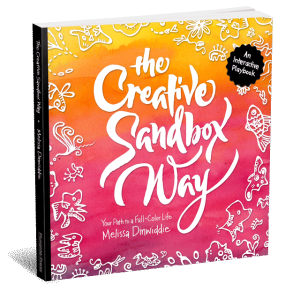

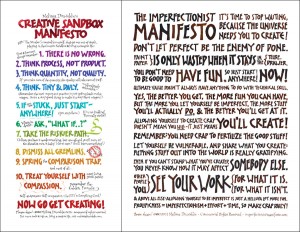
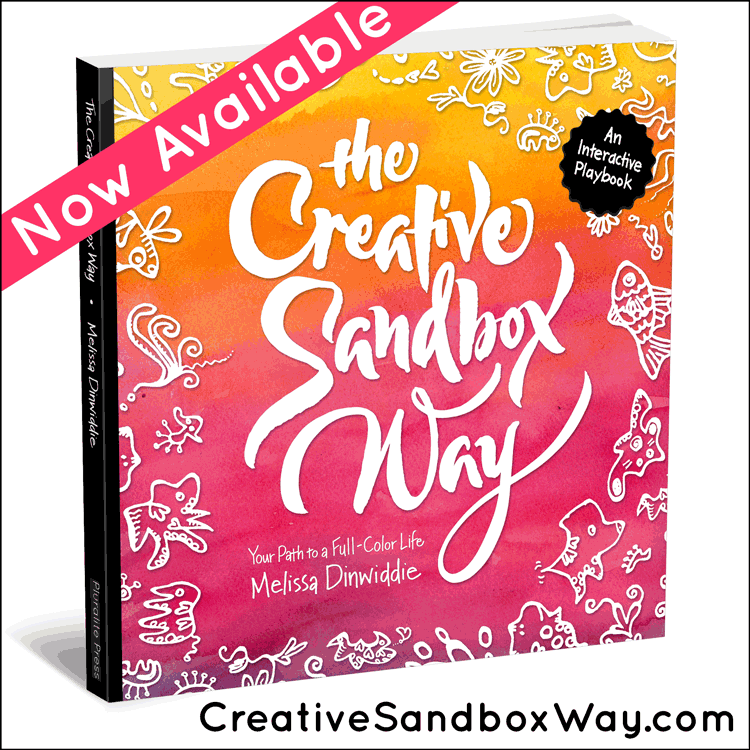
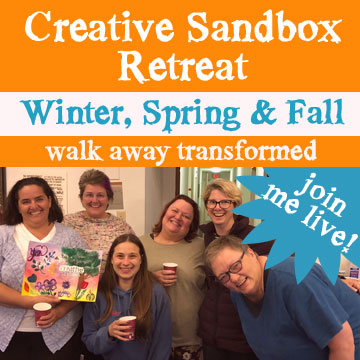
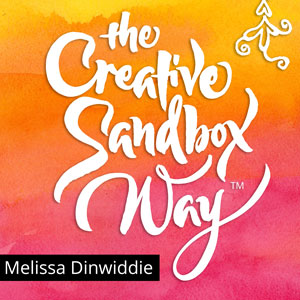

Leave a Reply